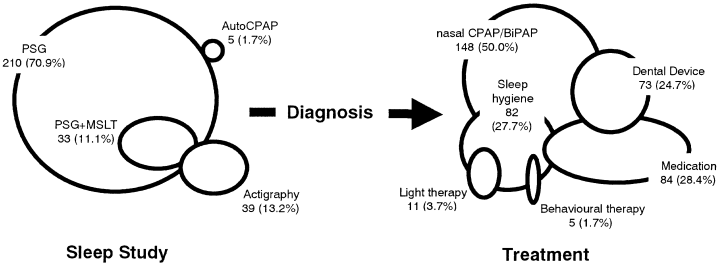A sleep disorders centre in the United Kingdom
Abstract
Abstract The demographic features of 296 patients who consulted a sleep disorders centre in the United Kingdom were reviewed. Diagnosis after a sleep study was mainly that of sleep-related breathing disorders; however, various other sleep disorders were also diagnosed. Considering that most sleep disorders are diagnosed only after sleep investigations, it should be emphasized that such a facility should be well prepared in undertaking not only polysomnography but also various sleep investigations, including multiple sleep latency testing and actigraphy. In addition, several treatment options, including sleep hygiene, light therapy, and behavioural therapy, should be available. Therefore, a sleep disorders centre needs to be operated by sleep specialists.
INTRODUCTION
Sleep disorders have been increasingly recognized as a cause of significant morbidity. They may affect daily performance and cause accidents while driving or at work, but many sleep disorders are potentially treatable. Sleep disorder centres are being established, hence enabling a greater number of patients to receive diagnosis and treatment of sleep disorders.1 However, a systematic review of sleep centres has not been undertaken in the United Kingdom. The present study reveals the demographic features of patients attending a sleep disorders centre in the United Kingdom, information which may be useful in establishing a sleep disorders centre in Japan.
METHODS
All 296 patients consulting the Sleep Disorders Centre, St Thomas’ Hospital in 1999 were included in the study. The medical records were reviewed by YO and the following clinical details were assessed: age, gender, source of referral, presumptive diagnosis by the referrer, and primary complaint at presentation. A detailed sleep history was taken and sleep investigations were also undertaken. These data were analysed to show the patient characteristics of the United Kingdom sleep disorders centre.
RESULTS
Two hundred and twenty-one patients (74.6%) were males, and patients’ age ranged from 9 to 79 years. A total of 132 patients (44.6%) were referred by a general practitioner (GP), whereas the remainder were referred from other specialities. Two hundred and ten patients (70.9%) underwent polysomnography and five patients underwent a simple respiratory examination using AutoSet continuous positive airway pressure (CPAP). Actigraphy was performed in 39 patients (13.2%) and a multiple sleep latency test (MSLT) was undertaken on 33 patients (11.1%) (Fig. 1). Among the patients who underwent sleep studies, sleep-related breathing disorder (SBD) was the most frequent diagnosis (60.5%). Periodic limb movement disorder and/or restless legs syndrome (5.6%) was the next most frequent diagnosis, followed by circadian rhythm disorder (4.7%), primary insomnia (4.2%), primary hypersomnia (3.7%), narcolepsy (3.7%), rapid eye movement (REM) sleep behavior disorder (3.3%), and extrinsic sleep disorders (2.8%) (Table 1). Sleep apnea syndrome was the presumptive diagnosis by the referring practitioner in 64 patients, and 49 of them (76.5%) had the diagnosis of SBD. As for treatments, nasal-CPAP/bilevel positive airway pressure (BIPAP) was tried on 148 patients (50.0%), and a dental device was tried on 73 patients (24.7%) for the treatment of SBD. Medication was used to treat 84 patients (28.4%), sleep hygiene for 82 patients (27.7%), light therapy for 11 patients (3.7%), and behavioural therapy was introduced to five patients (1.7%).

. Diagnostic procedures and treatment of sleep disorders.
| Sleep-related breathing disorders | 130 (60.5%) |
| PLMD/RLS | 12 (5.6%) |
| Circadian rhythm disorders | 10 (4.7%) |
| Primary insomnia | 9 (4.2%) |
| Primary hypersomnia | 8 (3.7%) |
| Narcolepsy | 8 (3.7%) |
| REM sleep behavior disorder | 7 (3.3%) |
| Extrinsic sleep disorders | 6 (2.8%) |
- PLMD, periodic limb movement disorder; RLS, restless legs syndrome; REM, rapid eye movement.
DISCUSSION
Under the United Kingdom National Health Service, patients are required to consult a GP first. This difference in the referral system may cause differences between the characteristics of sleep centres in Japan and the United Kingdom.
It is important that clinicians should be able to diagnose sleep disorders appropriately. Although more than 60% of patients were diagnosed as having SBD, various other sleep disorders were diagnosed at the centre. As most sleep disorders are diagnosed only after sleep investigations, such a facility should be well prepared in undertaking various sleep investigations including MSLT (for the diagnosis of idiopathic hypersomnia and narcolepsy) and actigraphy (for the diagnosis of circadian rhythm disorder and poor sleep hygiene). In addition, several treatment options, including sleep hygiene, light therapy, and behavioral therapy, were carefully chosen by sleep specialists depending on the sleep disorder of the patients.




